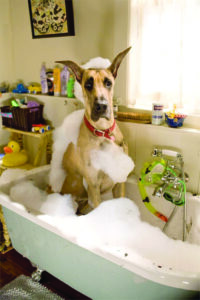By Dr. Beth Leermakers
Many small dogs — and some big ones — need regular grooming to keep their coats from becoming matted. My big dogs shed a moderate amount but don’t get matted coats, so grooming isn’t high on my list of dog mom activities. I recently picked up donated dog supplies, including shampoos in a variety of enticing scents like blueberry bliss. I can count the number of baths I’ve given my dogs on one hand. I rinse my Labrador Retriever after she goes swimming, but I rarely bathe her using shampoo.

Photo courtesy of Cuteness.com
How often should you brush and bathe your dog? Here’s what the experts recommend.
Brushing: The Key to Keeping Your Dog Clean
Brushing benefits all kinds of dogs regardless of breed, helping to remove dead hair, dirt and dandruff. Regular brushing also brings out the natural oils in the dog’s fur. As you brush, the natural oils are spread all over your pup’s fur, giving the coat a healthy sheen. To begin, brush your dog a few times a week for a few minutes at a time to create a routine. Use a brush that’s suited to your dog’s coat. Many dog parents swear by the Furminator for double-coated, high-shedding dogs. I use a rubber KONG ZoomGroom (like a curry comb) for my short-haired dogs.
How Often Should You Bathe Your Dog?
Dogs groom themselves to help facilitate the growth of hair follicles and to support skin health. However, most dogs need bathing to supplement the process.
Recommended bathing frequency depends on your dog’s breed, coat, health and activity level. Indoor couch potatoes may only need a bath a few times a year. Active dogs who hike, swim and roll in stinky stuff require more frequent trips to the tub. My husky mix had a knack for finding dead fish and horse manure during our Grapevine Lake outings. If you can smell your pup when he enters the room (or in the car on the way home!), he needs a bath.
Most healthy dogs don’t need to be bathed more than once a month. Bathing too often can be harmful — irritating the skin, damaging hair follicles and increasing the risk of bacterial or fungal infections. Inexpensive products can have harsh ingredients that irritate the skin and strip the natural oils.
Some dogs need medicated shampoo to treat medical conditions such as allergic skin disease. In this case, your veterinarian should tell you how often to bathe and what shampoo to use.
How to Bathe Your Dog
Brush your dog first to remove the heavy dirt. Putting your dog in the bathtub before brushing him leads to dirty bath water and an even dirtier dog.
Use the right products. Don’t use a “people shampoo” on your pooch. Human skin is very acidic (with a pH of under 5), while canine skin is neutral (pH closer to 7). Therefore, some products specifically designed for human skin will be drying and irritating to canine skin. For routine baths, use a gentle, moisturizing dog shampoo such as an oatmeal based one.
Use lukewarm water. Water that’s too hot or too cold will be unpleasant, which may turn bath time into a struggle. Test the temperature by spraying the water on your forearm, where the skin is more sensitive to temperature than your hands are.
Agitate the shampoo. Don’t just apply the shampoo and let it soak in. Actively massage the soap into your dog or cat’s fur with your hands and fingers for four minutes. Start with your pup’s legs and work your way up to his face (the most sensitive area).
Clean his face with a cotton ball or washcloth and be careful to avoid his eyes. Wash the outside of his ears with a tiny bit of shampoo on your fingers, a washcloth or a cotton ball. Tilt your pet’s head down before rinsing. If you’re washing his left ear, angle the left side of his head down to keep water from going into the ear canal and to prevent ear infections.
Rinse away the shampoo in the reverse order. Start with your dog’s head and then work your way down to his legs. That way, if any soap got in his eyes, you’ll rinse them first. Make sure the water runs clear of suds before you finish.
How Often Should You
Trim the Toenails?
Keeping your dog’s nails trimmed prevents your pup from dealing with unnecessary pain. Some people trim their dogs’ nails themselves, but I firmly believe that this grooming task is best left to trained professionals. If you cut the quick and draw blood, your dog may fight you the next time you approach with the clippers.
The amount of time between nail trims depends on how quickly your dog’s nails grow and how quickly they are worn down. The average dog should have his nails clipped every three to four weeks, but it should be done as often as needed to keep the nail from touching the ground when your dog is standing. Dogs that walk or run on pavement or rough surfaces may not need theirs done that often or at all, while lapdogs whose feet rarely touch the ground may need more frequent pedicures.
Grooming can be complicated. Different coat lengths and textures require different products and treatments. For example, a Shetland Sheepdog — a double-coated dog with thick, shedding hair — requires a good soaking and moisturizing with lots of water and a lot of brushing and combing before, during and after the bath, then a dog-specific conditioner, rinse and high velocity blow dry.
If you’re not up for this labor intensive process, take your pup to a groomer for a day of beauty.
